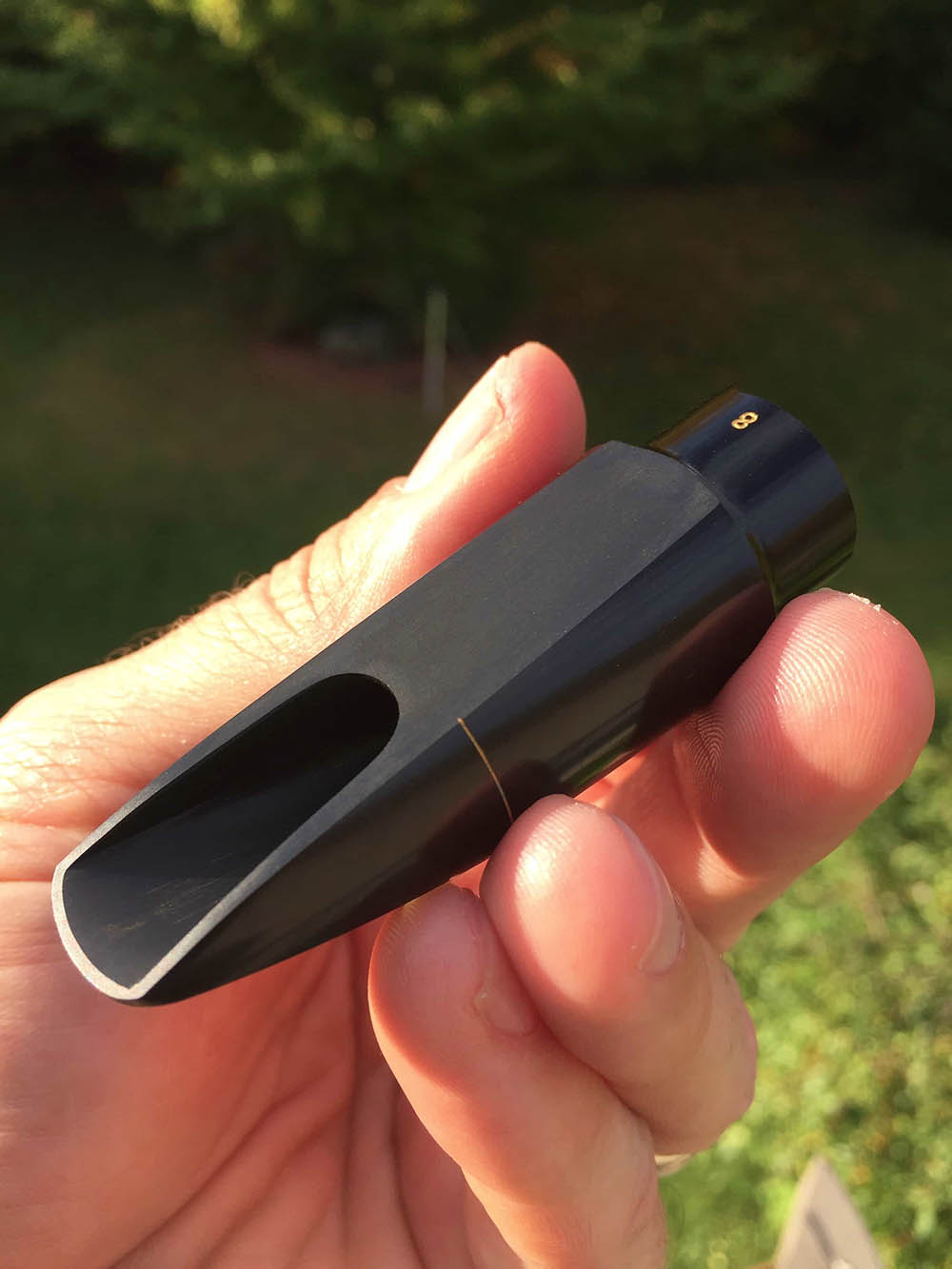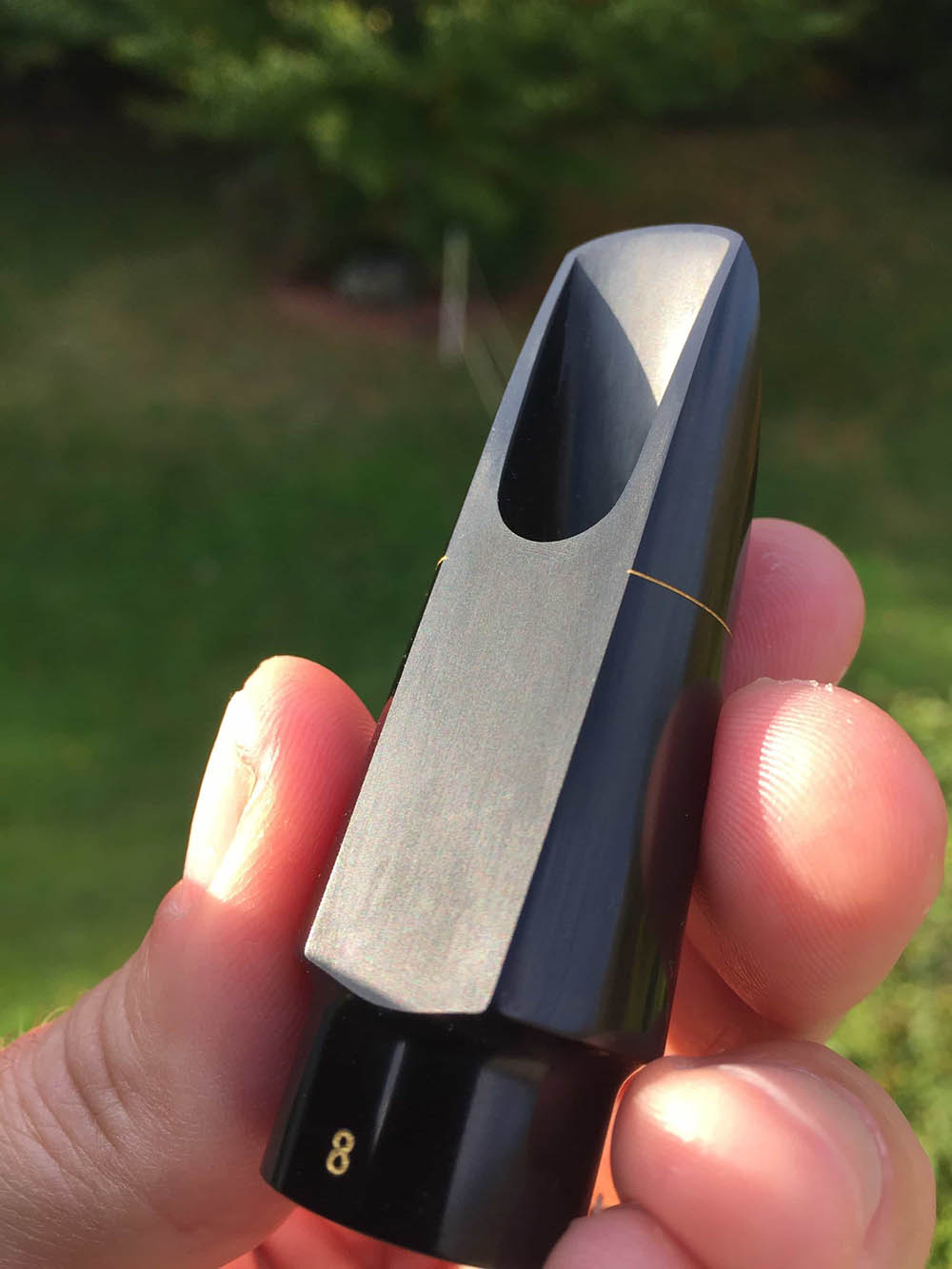Today, I am reviewing a great soprano saxophone mouthpiece made by Ken Okutsu at Okutsu mouthpieces in Japan. This is a hard rubber Okutsu Traditional model soprano saxophone mouthpiece with an 8 tip opening.
Ken Okutsu Traditional Soprano Saxophone Mouthpiece
Here is some information from the Okutsu website about the Okutsu Traditional soprano saxophone mouthpiece model:
Features
- Slight rollover baffle, and almost straight inner side walls and traditional round chamber.
- The beautiful vintage sound.
- All mouthpieces are crafted by CNC machinery for incredible accuracy and finished by hand carefully.
- Concave table. It makes the tone full and rich. The practical life span of reeds is lengthened.
- Material is the highest quality ebonite (hard rubber).
Ken Okutsu Traditional Soprano Saxophone Mouthpiece
The Okutsu Traditional soprano sax mouthpiece has a tip opening of an 8 which measures out to .067 according to the Okutsu website. The Traditional model has a slight rollover baffle and then the baffle heads down to a circular opening that is the entrance to the bore of the mouthpiece. The circular opening looks to be about 3/4 of the diameter of the bore size and is what I would consider a small chamber for a soprano sax mouthpiece. The side walls are slightly scooped and the roof of the mouthpiece chamber is very thick.
The mouthpiece side rails and tip look even and clean. The rails don’t look super thin but more of medium width as far as tips and rails go. The mouthpiece table is advertised as concave which is described as a good thing on the Okutsu website: “Concave table. It makes the tone full and rich. The practical life span of reeds is lengthened.”
I’m not sure if there is scientific proof to back this up but it is an interesting claim. I am curious why it would make the tone fuller and richer. Also, why would it increase the life span of a reed over a flat table? I did a search online and found a page where Mr. Okutsu attempts to answer these exact questions. The Okutsu website gives this explanation:
The Best Table Is Not Flat
The Table is the part of the mouthpiece that the reed is clamped onto by the ligature. Okutsu Mouthpieces make all tables very slightly concave from front to back. The concave table makes the tone full and the lives of the reeds long.
The facing curve begins at the split point of the side rails, as shown in the photo below. For the combination of a mouthpiece and a reed, it is the most important to make no leaks at the break points.
The break points are fulcrums of the vibration of the reed. If there are any slight leaks, the reed can not vibrate efficiently. The sound become dull and stuffy and maybe with many squeaking error tones.
The concave table is the equipment which the high quality mouthpieces have traditionally to avoid the leaks at the break points.
When the reed is clamped on the concave table, the reed is bent slightly by the pressure of the ligature. This causes the reed and the mouthpiece to push against each other at the break points.
Used reeds become warp by the moisture. When the warp is slighter than the concavity on the table, the influence of the reed warp is canceled. It is the advantage of the concave table. It makes the tone full and the practical life span of reeds is lengthened.
Some mouthpiece makers and refacers insist that the perfect flat table is the best design. I don’t agree with the opinion. The perfect flat table is suitable with only the perfect flat reeds. But used reeds with flat back are very few.
Whoa! This is worthy of a whole other blog post to discuss, I love this stuff………..
Ken Okutsu Traditional Soprano Saxophone Mouthpiece
Regardless of the discussion about the best surface for a saxophone mouthpiece table, I will admit here and now that I feel there is something special and unique about the Okutsu sax mouthpieces I have played and reviewed to date. There is a certain character and response that they have that is different than many of the flat table mouthpieces I have collected. I’m not saying it is better or worse but just that I perceive it as different and unique. I don’t know if it is even the table or something else but they have a certain character and individuality to their sound.
Ken Okutsu Traditional Soprano Saxophone Mouthpiece
The Okutsu Traditional soprano saxophone mouthpiece played best for me with a softer soprano saxophone reed. On the sound clips below I am using a BSS (Boston Sax Shop) 2 1/2 soprano saxophone reed which I found to be the perfect strength for this Okutsu soprano sax mouthpiece.
The sound of the Okutsu Traditional soprano sax mouthpiece was light, delicate and focused. I would say the tone was in the middle of the dark to bright range of a soprano tone and leaned a bit the brighter side of the range when pushed in volume. The tone seems to lend itself nicely to beautiful melodies and when playing fast it sounded graceful and light while playing fast bebop lines.
Any brightness the Okutsu Traditional soprano mouthpiece has is balanced out with that light and delicate quality so the tone never seems heavy and too edgy in my opinion. It always keeps this refined beauty to the tone throughout the sound clip which I enjoyed.
Ken Okutsu Traditional Soprano Saxophone Mouthpiece
The intonation of the Okutsu Traditional soprano saxophone mouthpiece was excellent with most of my glances at the tuner on various notes while warming up being right on the “0” of the tuner.
The low notes were easy to produce as well as sub-tone and the high notes came out effortlessly. The high notes had a delicate elegance to them that was natural sounding and beautiful.
The articulation was crisp and immediate and the range of the soprano saxophone was even and uniform in my opinion.
Ken Okutsu Traditional Soprano Saxophone Mouthpiece
I provide one sound clip below in two different formats. They are both the same sound clip but the first one has a reverb added and the second one is a dry recording (no effects or reverb whatsoever). I like to add a sound clip with reverb at times to give readers of these reviews an idea of how a mouthpiece might sound in a room with natural reverb or in a recording studio with reverb added.
What strikes me about these two recordings, is that the Okutsu Traditional soprano sax mouthpiece sounds equally great with reverb as well as dry. The dry recording still sounds pretty and light in tone. The middle and high range of the soprano sax have a beautiful sparkle to the notes that made them very pleasant to listen to in my opinion.
Ken Okutsu Traditional Soprano Saxophone Mouthpiece
Thanks to Ken Okutsu for sending me this Traditional model soprano saxophone mouthpiece to review. Please also check out the other Ken Okutsu saxophone mouthpieces that I have reviewed here on the website. They are all made with excellent craftsmanship and I thought each of them played great.
If you like the sound of the Okutsu Traditional soprano saxophone mouthpiece, you can find them at the Okutsu website which in in Japanese and English (just click on the word “English” on the far right of the website menu)
If you have played or end up playing a Ken Okutsu Traditional soprano saxophone mouthpiece or have any other thoughts or comments about this review, I would love to hear what you think in the comments below. Thanks, Steve
Ken Okutsu Traditional Soprano Saxophone Mouthpiece-BSS (Boston Sax Shop) 2 1/2 S0prano Sax Reed-Reverb Added
Ken Okutsu Traditional Soprano Saxophone Mouthpiece-BSS (Boston Sax Shop) 2 1/2 S0prano Sax Reed-Dry Recording (No Effects)









I have played the Tenor High Baffle Okutsu piece for a few years now ( thanks to your recommendation). The workmanship is of the highest quality. It is my go-to piece….maybe the best that I have ever played.
Yeah, I sold the high baffle Okutsu tenor mouthpiece I reviewed and regret it. That was a great playing mouthpiece!
???
Veri, very, very good sound!
Giuseppe.
Nice sound. I’m playing on an Ed Pillinger Soloest copy which has a very similar sound in my ears.
How do you purchase this mouthpiece?
Edward, At the bottom of the review is a link to the Okutsu website (it’s in the second to last paragraph) where you can purchase the mouthpiece. The website text should come up in English but if it doesn’t, there is a menu option on the right of the main menu to choose english as the language.